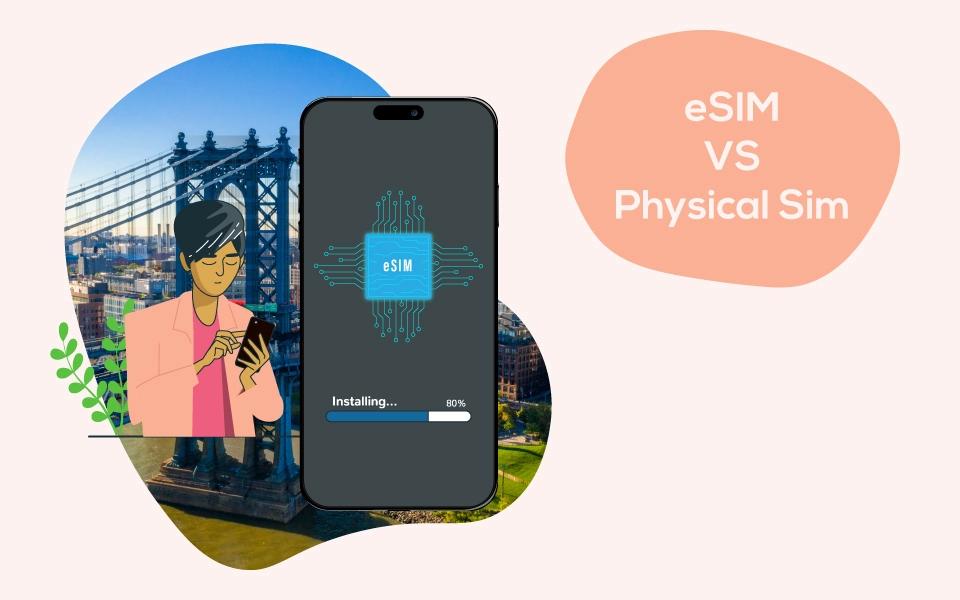
eSIM Security: Assessing the Risks and Benefits
eSIM is an advanced communication solution evolving among travellers and offers flexibility and convenience. However, digital solutions can bring a threat to your personal life data, and you need to understand the security implications associated with eSIM technology.
Today, we will learn about eSIM security, highlighting potential risks and how it compares to traditional and physical SIM cards.
Understanding eSIM Security
eSIM is an outstanding innovation that eliminates the physical SIM card, frustrating swaps, and remote integration into your device. It is an embedded SIM that provides inherent security advantages:
- Reduced Physical Theft Risks - There is no risk of SIM theft because someone needs to steal your device to reach your eSIM profile.
- Enhanced Protection Against Cloning - Compared to physical SIM cards, the embedded design of eSIMs almost eliminates the chance of SIM cloning crime.
What are the Potential Security Risks of eSIMs?
Where there are benefits of using eSIM technology while you are travelling or for business purposes, there are some potential security risks of eSIM you should be aware of:
Remote Hacking Attempts
Cyberattacks may likely exploit vulnerabilities in the eSIM setup process. By porting your target phone number into a new eSIM card, cyberattackers can steal your target phone number.
Social Engineering Attacks
By performing social engineering tactics, hackers can attack your eSIM profile. This is possible when hackers obtain the necessary credentials and personal information of your eSIM profile. They don’t steal your identity but trick you into handing over the information.
Comparative Analysis: eSIM Vs. Physical SIM Security
eSIM security is no doubt based on advanced security protocols, but when you compare eSIM to physical SIM cards, the following factors come into play:
SIM Swapping Vulnerability
SIM swapping attacks are common for both eSIMs and physical SIM cards. The attacks are initiated by tricking carriers into transferring the victim’s phone number to a new SIM. As eSIMs involve remote activation, there are security layers that attackers have to bypass. This will reduce the chance of a SIM swapping attack for eSIM.
Physical Tempering
As eSIM is the digital version of connectivity, there is no such physical approach to eSIM unless your device gets stolen. For physical SIM cards, they can be removed and tampered with.
What are the best practices for enhancing eSIM security?
The following are the ways through which you can maximise the security of your eSIM-enabled device:
- Regular Software Updates - Regular device updates are essential because they contain security patches. You need to perform regular updates the moment you receive a notification. This will protect your eSIM profile against known vulnerabilities.
- Strong Authentication Methods - Adding layers of security to your device can reduce the risk of hacking. Try to utilise robust passwords and enable biometric authentication.
- Be Wary of Phishing Attempts - Attackers are highly skilled with trick frauds to gather your information by calling or using different means. Remain vigilant against such activities.
Future Look: Advancements in eSIM Security
eSIM is already in the revolutionising phase, and the future is promising. The security developments are being processed and will soon reach the highest levels. So, what is happening to enhance eSIM security:
- Improved Encryption Standards - Besides activating QR codes, developments in encryption will protect eSIM data during transmission and storage.
- Enhanced Carrier Protocols - eSIM works with different network carriers, and these carriers are updating their security protocols to minimise the possibility of cyber-attacks and prevent unauthorised eSIM provisioning.
Conclusion
eSIM security defines its advancement level and is predicted to reach high levels shortly. By reading this blog, you know the potential risks to eSIM security. You can follow best practices to mitigate potential threats and use eSIM confidently. If you are serious about your data security and looking for an eSIM provider to ensure security, buy Phonico eSIM! They have applied the best possible security protocols to provide users with secure and seamless connectivity.
FAQs
Can an eSIM be hacked?
Yes, it can be hacked because no technology is immune to hacking. Potential risks always exist, such as unauthorised access or social engineering attacks.
Can eSIMs be cloned?
Although challenging, eSIM can be cloned if the attacker bypasses the advanced security protocols. If you regularly perform device updates for security patches, eSIM cannot be cloned.
What happens if my phone with an eSIM is stolen?
If your eSIM-enabled device got stolen, you became a victim of unauthorised access to your account remains.
_image_1694091892.webp&w=3840&q=75)






